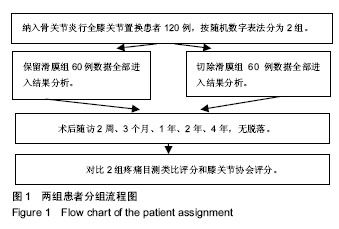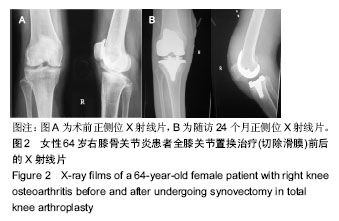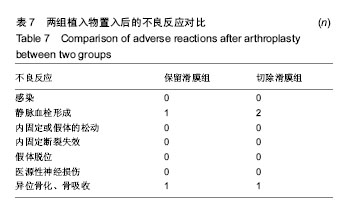| [1] Sehat KR, Evans RL, Newman JH. Hidden blood loss following hip and knee arthroplasty correct management of blood loss should take hidden loss into account. J Bone Joint Surg Br. 2004; 86(6):561-565.[2] Tanavalee A, Honsawek S, Rojpornpradit T, et al. Inflammation related to synovectomy during total knee replacement in patients with primary osteoarthritis: a prospective-randomised study. J Bone Joint Surg Br. 2011;93(8):1065-1070.[3] Tsung JD, Rohrsheim JA, Whitehouse SL, et al. Management of periprosthetic joint infection after total hip arthroplasty using a custom made articulating spacer (CUMARS); the Exeter experience. J Arthroplasty. 2014;29(9):1813-1818.[4] Garven KL, Konigsberg BS. Infection following total knee arthroplasty: prevention and management. Instr Course Lect. 2012;61:411-419.[5] Xie J, Ma J, Yao H, et al. Multiple boluses of intravenous tranexamic acid to reduce hidden blood loss after primary total knee arthroplasty without tourniquet: A randomized clinical trial. J Arthroplasty. 2016;31(11):2458-2464.[6] Pedersen AB, Sorensen HT, Mehnert F, et al. Risk factors for venous thromboembolism in patients undergoing total hip replacement and receiving routine tromboprophylaxis. J Bone Joint Surg Am. 2010;92(12):2156-2164.[7] 刘晓雅,孙永强,刘国杰. 主动快速康复锻炼对全膝关节置换术后关节活动度的影响[J]. 中医正骨, 2015,27(9):73-74.[8] 兰如华,孟建,程振东,等. 快速康复外科理念应用于初次人工全膝关节置换术围手术期的研究进展[J]. 中医正骨, 2017,29(10):44-46.[9] Parvizi J, Miller AG, Gandhi K. Multimodal pain management after total joint arthroplasty. J Bone Joint Surg Am. 2011;93(11): 1075-1084.[10] 丁汉飞,肖李冰,陆启祥. 类风湿关节炎早期切除50例[J]. 中国骨伤, 2002,15(2):179-180.[11] Katschke KJ, Jr Rottman JB, Ruth JH, et al. Differential expression of chemokine recepters on peripheral blood, synovial fluid, and synovial tissue monocytes/macrophages in rhermatoid arthritis. Arthritis Rheum. 2001;44:1022-1032.[12] Hunter DJ. Imaging insights on the epidemiology and pathophysiology of osteoarthritis. Rheum Dis Clin North Am. 2009;35(3):447-463.[13] 李治国,杨晓茂,杨洪军,等. 切除滑膜对骨性关节炎全膝关节置换术后近期疗效及康复效果的影响[J]. 检验医学与临床, 2014,11(5): 636-637.[14] 赵旭红,伍骥,李松林,等. 全膝关节置换同时进行滑膜切除术与否对初期骨关节炎患者术后炎性周期及临床结果的影响[J]. 中国矫形外科杂志, 2013,21(3):238-242.[15] 徐昭宁,杨旭,田少奇等. 滑膜切除对全膝关节置换术术后失血及功能恢复的影响[J]. 中华临床医师杂志(电子版),2013,7(4): 1553-1556.[16] 李建锋,崔学文. 初次全膝关节置换切除滑膜与失血量及关节功能的相关性[J]. 中国组织工程研究, 2018,22(11):1659-1664.[17] 唐炼. 氨甲环酸对膝关节置换术患者静脉与关节内失血的影响研究[J]. 中国生化药物杂志, 2014,34(7):105-107.[18] 郑嘉晖,张津杰,金敏伟,等. 氨甲环酸在全膝关节置换术中的应用[J]. 中医正骨, 2017,29(12):43-44.[19] Li GL, Li YM. Oral tranexamic acid can reduce blood loss after total knee and hip arthroplsty: A meta-analysis. Int J Surg. 2017; 46:27-36.[20] 王云龙,甄平. 单侧全膝关节置换围置换期的阴性失血:问题与特点[J]. 中国组织工程研究,2018,22(11):1786-1791.[21] 任国清,刘红云,滕学仁,等. 人工全膝关节置换后是否放置引流管:随机对照试验[J]. 中国组织工程研究, 2016,20(22):3219-3226.[22] Zhang S, Xu B, Huang Q, et al. Early removal of drainage tube after Fast-Track primary total knee arthroplasty. J Knee Surg. 2017;30(6):571-576.[23] Vignali A, Elmore U, Cossu A, et al. Enhanced recovery after surgery(ERAS) pathway vs traditional care in laparoscopic rectal resection: a single-center experience. Tech Coloproctol.2016; 20(8):559-566.[24] Xu XW, Feng T, Gao X, et al. Fast-track surgery and exclusive enteral nutrition applied to a rat model of heterotopic intestinal transplantation. Exp Ther Med. 2016;11(3):933-938.[25] Nanavati AJ. Fast track surgery in the elderly: avoid or proceed with caution? J Gastrointest Surg. 2015;19(12):2292-2293.[26] Wang JY, Hong X, Chen GH, et al. Clinical application of the fast track surgery model based on preoperative nutritional risk screening in patients with esophageal cancer. Asia Pac J Clin Nutr. 2015;24(2):206-211.[27] Triqkilidas D, Anand A. The effectiveness of hyaluronic acid intra-articular injections managing osteoarthritic knee pain. Ann R Coll Surg Enql. 2013;95(8):545-551.[28] Kilicarlan K, Yalcin N, Clcek H, et al. The effect of total synovectomy in total knee arthroplasty: a prospective randomized controlled study. Knee Surg Sports Traumatol Arthrosc. 2011; 19(6):932-935.[29] 孙相祥,马建兵,肖琳,等. 人工全膝关节置换术中保留滑膜对术后感染的预防效果[J]. 安徽医药, 2018,22(5):848-853. |
.jpg)




.jpg)
.jpg)